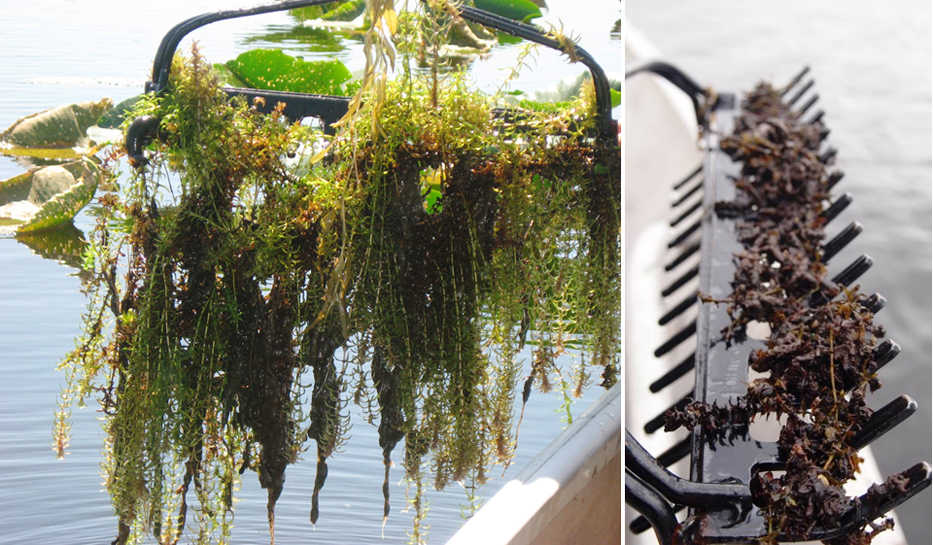I am fascinated by how plants and animals are named. Elodea, the first submersed freshwater invasive plant to infest Alaska, was named by the famous French botanist André Michaux. Michaux was first sent to the U.S. in 1785 by Louis XVI. After the misguided French king was beheaded, Thomas Jefferson asked Michaux to lead another American expedition in 1793. Michaux collected several specimens in the Midwest that he later assigned to the new genus Elodea, meaning “marshy” in Greek.
Elodea does indeed grow in marshy habitat. But where introduced outside its native range, elodea can also turn otherwise clear lakes into marshy habitat due to several unusual traits. It’s incredibly facile at dispersing, reproducing asexually from just a plant fragment. It’s marvelously prolific, continuing to photosynthesize under the ice after native plants have senesced.
And, unlike most native plant species that have evolved to occupy specific depths or one stratum in the water column, the perennial elodea can root into the bottom substrate as deep as 30 feet and send continuous strands to the top of the water column where it spreads across the water’s surface. Its growth can be so hyper-abundant that boat traffic is impeded and lakeshore property values drop, and the biological oxygen demand so great that salmon and other fish are deprived of oxygen. Elodea represents an enormous economic and ecological threat to aquatic and fisheries resources of the peninsula, particularly in the 4,000 or so lakes and ponds of the Kenai Lowlands.
For these reasons, partners in the Kenai Peninsula Cooperative Weed Management Area decided that elodea had to be eradicated from the peninsula after it was first detected in Stormy Lake in September 2012. During summer 2013, surveys of 69 high-risk lakes confirmed that the current elodea distribution on the peninsula is constrained to just three lakes north of Nikiski. Stormy Lake is co-managed by Alaska State Parks and the Kenai National Wildlife Refuge. Beck and Daniels Lakes, with many private landowners, drain into Bishop Creek, which wanders in and out of the Refuge enroute to the Cook Inlet.
This past winter, the U.S. Fish and Wildlife Service, Alaska Department of Natural Resources, Homer Soil & Water Conservation District, Alaska Department of Fish & Game, Alaska State Parks, Cook Inlet Aquaculture Association, UAF Cooperative Extension Service, Kenai Peninsula Borough, Kenai Watershed Forum and a few dedicated Daniels Lake residents developed a plan that detailed how this eradication was to come about.
We chose to work primarily with fluridone — a selective, systemic herbicide that inhibits carotene formation, a plant pigment needed for photosynthesis, thereby preventing the formation of sugars necessary to sustain elodea. Working closely with SePRO, the manufacturer of fluridone products sold under the trade name Sonar, we developed a prescription that calls for four treatments over a 3-year period (2014-16).
We applied the first two treatments to each of the three infested lakes this summer. Beck and Daniels Lakes were first treated in early June. We applied both liquid and slow-releasing pelleted fluridone in Beck Lake. In Daniels, because elodea has not yet spread throughout the lake, we applied both pelleted fluridone and diquat, a nonselective contact herbicide, to five treatment areas that total less than 100 acres of the 640-acre lake.
Stormy Lake was also treated with both fluridone formulations, but not until late July due to delayed funding. We then applied a second round of pellets to all three lakes in mid-September, with the expectation that very low concentrations (< 8 ppb) of fluridone under the ice would continue to have herbicidal effects on elodea all winter.
To monitor treatment efficacy, we established 50 sites in each of the three lakes (150 sites total). Pre- and post-treatment elodea populations were measured in late May and early September, respectively.
So how are we doing? For two lakes, the results were spectacular. Thirteen weeks after the first treatment, elodea occurrence in Beck Lake (the most infested of the 3 lakes) decreased from 70 percent to 12 percent of sites, with average abundance declining by 87 percent. In Daniels Lake, elodea occurrence decreased from 22 percent to ZERO — not a fragment was found! But this dramatic outcome is likely due (at least in part) to diquat, which kills exposed plants on contact but not roots beneath the sediment.
In Stormy Lake, where elodea grew unhindered most of the summer before being treated on July 23, the population had not yet been significantly affected by herbicidal action when surveyed in mid-September. Although many strands were showing pink tips (a sign of necrosis), elodea fragments were everywhere in Stormy, even washed up on yellow pond-lily pads. The good news is that with fluridone uptake occurring under the ice, we expect elodea to continue dying over the winter.
Sometime in February, we’ll auger through the ice to take water samples for assaying fluridone concentrations. After the ice goes out in May, we’ll resample our 150 sites for elodea. No promises, but I anticipate that elodea will be all but gone in Beck and Daniels Lakes, and very sparse in Stormy Lake, by next spring. Scheduling of the third herbicide treatment in 2015 depends on what we find about fluridone concentrations and elodea populations after ice-out, but it will likely be in late June.
Despite great progress, it ain’t over ‘til the fat lady sings or, in this case, until elodea is gone, gone, gone. Even after elodea is no longer detected on our 150 sites, we will survey extensively elsewhere to ensure it no longer occurs on the Kenai Peninsula.
Dr. John Morton is the supervisory biologist at Kenai National Wildlife Refuge. Find more information about the Refuge at http://kenai.fws.gov or http://www.facebook.com/kenainationalwildliferefuge.

